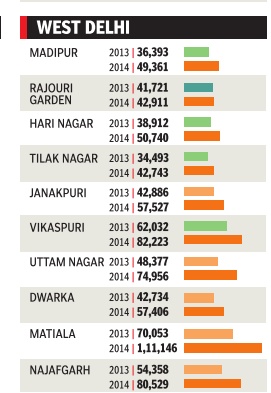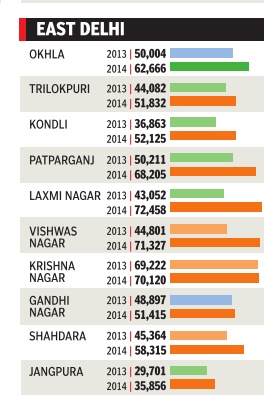Delhi: Parliamentary elections
This is a collection of articles archived for the excellence of their content. Readers will be able to edit existing articles and post new articles directly |
Contents |
Delhi results reflect the mood of the nation
1951-2014
Capital a bellwether for national results
TIMES INSIGHT GROUP
New Delhi: Given the fact that Delhi accounts for just seven of 543 Lok Sabha seats, it might seem like what happens in the capital is just a minor detail in the larger national calculus. The fact, however, is that Delhi has reflected the national mood with remarkable accuracy over the years, at least as far as the Congres and BJP — or the erstwhile Jan Sangh — are concerned.
So will what happens in Delhi on Thursday decide India’s fate in 2014? Don’t bet against it. The odds seem heavily in favour of that happening.
In the 15 Lok Sabha elections till date (beginning 1952), only twice, in 1967 and 1991, has a party lost a majority of the seats in Delhi and gone on to be part of the government in New Delhi. Even on those two occasions, the results in the capital did indicate a larger national trend.
In 1967, the Jan Sangh won six seats and the Congres just one; the latter formed the central government led by Indira Gandhi [with a greatly reduced majority. Besides, several north Indian states voted somewhat like Delhi did.] This was the year in which the Congres faced major setbacks across northern India. Non-Congres governments came to power across the region, giving rise to a popular saying that for the first time you could travel from West Pakistan to East Pakistan through India without setting foot on Congres territory. Its Lok Sabha tally too dropped below 300 for the first time.
In 1991, the BJP won five seats and the Congres two, but P V Narasimha Rao headed the government in New Delhi. However, Congres failed to get a majority in the Lok Sabha; but for the sympathy wave that followed Rajiv Gandhi’s assassination mid-way through the polls, it would quite possibly have failed to form the government.
These two elections apart, a loss in Delhi has meant bidding goodbye to hopes of ‘power’ at the Centre. The capital has seen clean sweeps in seven of the 15 LS polls. On each occasion, the party sweeping the capital — Congres in 1957, 1962, 1971, 1984 and 2009; Janata Party in 1977 and BJP in 1999 — has won a majority in LS, either on its own or with its pre-poll allies.
The 2014 parliamentary elections confirmed the trend. The BJP won all 7 seats from Delhi. It also won the majority of seats in the country on its own and formed the national government in alliance with its NDA partners.
1951-1991; 1996-2019

From: May 24, 2019: The Times of India
See graphic:
1951-1991; 1996-2019: Delhi’s LS election results reflect the mood of the nation
Voters
2019

From: Atul Mathur, 3.3L voters added to list since final electoral rolls: CEO, March 26, 2019: The Times of India
See graphic:
Voters in Delhi, 2019, LS constituency-wise
Voters’ turnout on election day
1952-2024

in Delhi, 1952-2024
In other metropolitan cities of India: 2019, 2024
From: May 26, 2024: The Times of India
See graphic:
Voters’ turnout on election day
in Delhi, 1952-2024
In other metropolitan cities of India: 2019, 2024
ELECTION-WISE TRENDS
2014
The victorious candidates
Name, party
|
S.No. |
Costituency |
Name Of Member |
Party |
|
1 |
Chandni Chowk |
Dr. Harsh Vardhan |
BJP |
|
2 |
East Delhi |
Maheish Girri |
BJP |
|
3 |
New Delhi |
Meenakashi Lekhi |
BJP |
|
4 |
North East Delhi |
Manoj Tiwari |
BJP |
|
5 |
North West Delhi |
Udit Raj |
BJP |
|
6 |
South Delhi |
Ramesh Bidhuri |
BJP |
|
7 |
West Delhi |
Parvesh Sahib Singh Verma |
BJP |
Lok Sabha results: assembly segment-wise
There are eight graphics with this news report.
BJP bagged 60 assembly segments in city, AAP 10
Ambika Pandit
The Times of India May 18 2014
The Times of India May 18 2014
Middle class angry, AAP vote bank volatile VOTERS' CHOICE: THEN AND NOW
The Delhi assembly landscape changes dramatically if the Lok Sabha election results are analysed.
It's a BJP sweep with only 10 for AAP
The Congres didn't just finish a poor third in all seven Lok Sabha constituencies in Delhi. Its humiliation in the national capital runs much deeper it was third in all but one of the 70 assembly segments as well. The lone exception was the Muslim-dominated Matia Mahal segment where it was second to AAP and ahead of the BJP.
In all, BJP led in 60 of the 70 assembly segments and AAP in 10, including Matia Mahal, Seelampur, Seemapuri, Okhla, Badli, Kirari, Sultanpur Majra, Ambedkar Nagar, Sangam Vihar and Kalkaji.
The assembly segment-wise break-up of votes could well add to the feeling in BJP that early assembly polls would suit it well though the party would be aware that voting patterns in parliamentary elections do not necessarily get replicated in state elections.
The contest for 2014 clearly remained mainly between the “Modi wave“ and AAP's anti-corruption campaign even at the local level. In fact, given the fact that the Congres got a dismal 15.1% of the total votes polled and finished third even in the eight seats it won in December, it faces the frightening prospect of being seen as a “spoiler“ for AAP if the assembly polls are held anytime soon. A week after demitting office, Aam Aadmi Party leader and former chief minister Arvind Kejriwal had moved the Supreme Court to press for fresh elections in the city. While Kejriwal alleged the Centre's move to impose President's rule was “malafide“, a section of AAP MLAs has come round to the view that cobbling together another coalition would be in the city's interest.
AAP's loss
AAP resigned from government on February 14 after 49 days in power. Since then, Delhi assembly has been in a state of suspended animation.
AAP faces a challenge as its supporters appear to be volatile vote banks shifting choices between December and April.
The middle class has largely gone with BJP , deserting AAP in seats where it got top slot in the assembly polls. In contrast, large sections of Muslims have clearly broken away from Congres to go with AAP .
In Chandni Chowk parliamentary constituency , the split in Muslim votes shows in Matia Mahal and Ballimaran. Of the 10 segments here, while BJP led on nine seats, AAP won the top slot with 30,953 votes in Matia Mahal, a constituency reflecting the mood of the minorities.
In fact, in Chandni Chowk assembly segment, a traditional Congres stronghold marked by a concentration of Muslims in some places, the BJP led with 26,223 votes due to the middle class support. AAP was behind by 6,000 votes at 21,233 votes followed by Congres at 19,984 votes. Despite the consolidation of Muslim votes, the “Modi wave“ kept its grip.
In East Delhi, the results show the BJP led on nine seats. Here too, AAP earned the top slot in Okhla, another Muslim-dominated seat retained by Congres in December. AAP managed an impressive 62,666 votes, a lead of almost 24,000 over BJP's 39,914. The Congres was third with 39,445 votes. Areas like Laxmi Nagar, Patparganj, Vishwas Nagar and Gandhi Nagar, where the middle class thrives, and even densely-populated, low-income areas like Trilokpuri favoured BJP over AAP . For instance, in Patparganj where AAP's Manish Sisodia is an MLA, BJP led with 68,205 votes and AAP's Rajmohan Gandhi trailed at 41,872 votes.
In Northeast Delhi, BJP led in eight assembly seats. AAP led in Seemapuri, an SC reserved constituency with 47,491 votes. AAP also led in Muslim dominated Seelampur, which the Congres had managed to retain in the assembly polls. In minority areas like Babarpur and Mustafabad too, Congres was pushed to the third place with AAP ending runners-up.
It is in New Delhi parliamentary constituency that the shift of the middle class from AAP to BJP is most visible. AAP had won eight of 10 assembly seats in December here, but now the middle class has consigned it to second place. The impact of the Modi wave was most evident in areas like Greater Kailash, Malviya Nagar, Patel Nagar and Karol Bagh. In Arvind Kejriwal's New Delhi assembly seat too, BJP led by nearly 13,000 votes.
In Northwest Delhi, AAP managed to get the top slot in three seats, including Badli, Kirari and Sultanpur Majra. Rakhi Birla, an MLA from Mangolpuri, trailed in her own seat to BJP by a margin of over 10,000 votes. The middle class of Rohini went all out to support BJP . Sultanpur Majra, the only one of Delhi's reserved constituencies that Congres won in December, gave AAP the lead.
The Punjabis and Sikhs of West, making up a strong middle class, and the rural, Jatdominated belt of Matiala and Najafgarh backed BJP.
In South Delhi, dominated by unauthorised colonies, resettlements and rural and urban settlements, seven seats yielded leads for BJP with AAP in the top slot in Ambedkar Nagar, Sangam Vihar and Kalkaji.
See also
Delhi: Assembly elections,2015
Delhi: elections-related issues
Delhi: Local bodies’ elections
Delhi: Parliamentary elections








